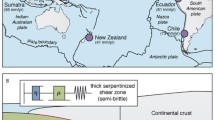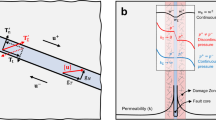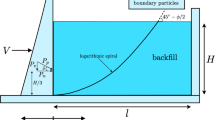Abstract
A better understanding of how slip accumulates along faults and its relation to the breakdown of shear stress is beneficial to many engineering disciplines, such as, hydraulic fracture and understanding induced seismicity (among others). Asperities forming along a preexisting fault resist the relative motion of the two sides of the interface and occur due to the interaction of the surface topographies. Here, we employ a finite element model to simulate circular partial slip asperities along a nominally flat frictional interface. Shear behavior of our partial slip asperity model closely matched the theory described by Cattaneo. The asperity model was employed to simulate a small section of an experimental fault formed between two bodies of polymethyl methacrylate, which consisted of multiple asperities whose location and sizes were directly measured using a pressure sensitive film. The quasi-static shear behavior of the interface was modeled for cyclical loading conditions, and the frictional dissipation (hysteresis) was normal stress dependent. We further our understanding by synthetically modeling lognormal size distributions of asperities that were randomly distributed in space. Synthetic distributions conserved the real contact area and aspects of the size distributions from the experimental case, allowing us to compare the constitutive behaviors based solely on spacing effects. Traction-slip behavior of the experimental interface appears to be considerably affected by spatial clustering of asperities that was not present in the randomly spaced, synthetic asperity distributions. Estimates of bulk interfacial shear stiffness were determined from the constitutive traction-slip behavior and were comparable to the theoretical estimates of multi-contact interfaces with non-interacting asperities.







Similar content being viewed by others
References
ABAQUS/CAE user’s manual: version 6.4. Pawtucket, RI: ABAQUS (2003)
Abercrombie RE, Rice JR (2005) Can observations of earthquake scaling constrain slip weakening? Geophys J Int 162(2):406–424. doi:10.1111/j.1365-246X.2005.02579.x
Aki K (1967) Scaling law of seismic spectrum. J Geophys Res 72(4):1217–1231
Andrews DJ (1976) Rupture propagation with finite stress in antiplane strain. J Geophys Res 81(20):3575–3582. doi:10.1029/JB081i020p03575
Archard JF (1953) Contact and rubbing of flat surfaces. J Appl Phys 24(8):981–988. doi:10.1063/1.1721448
Archard JF (1957) Elastic deformation and the laws of friction. Proc R Soc Lond A Math Phys Eng Sci 243(1233):190–205. doi:10.1098/rspa.1957.0214
Archard JF (1961) Single contacts and multiple encounters. J Appl Geophys 32(8):1420–1425. doi:10.1063/1.1728372
Ariyoshi K, Hori T, Ampuero JP, Kaneda Y, Matsuzawa T, Hino R (2009) Influence of interaction between small asperities on various types of slow earthquakes in a 3-D simulation for a subduction plate boundary. Godwana Res 16:534–544
Ariyoshi K, Matsuzawa T, Ampuero JP, Nakata R, Hori T, Kaneda Y, Hino R, Hasegawa A (2012) Migration process of very low-frequency events based on a chain-reaction model and its application to the detection of preseismic slip for megathrust earthquakes. Earth Planets Space 64(8):693–702. doi:10.5047/eps.2010.09.003
Berthoude P, Baumberger T (1998) Shear stiffness of a solid solid multicontact interface. Proc R Soc Lond A 454(1974):1615–1634. doi:10.1098/rspa.1998.0223
Boitnott GN, Biegel RL, Scholz CH, Yoshioka N, Wang W (1992) Micromechanics of rock friction 2: quantitative modeling of initial friction with contact theory. J Geophys Res 97(B6):8965–8978
Bouton GD (2014) CorelDRAW X7: the official guide, 11th edn. McGraw-Hill Education Group, New York
Brodsky EE, Lay T (2014) Recognizing foreshocks from the 1 April 2014 Chile earthquake. Science 344(6185):700–702. doi:10.1126/science.1255202
Brune JN (1970) Tectonic stress and spectra of seismic shear waves from earthquakes. J Geophys Res 75(26):4997–5009. doi:10.1029/JB075i026p04997
Cattaneo C (1938) Sul contatto di due corpi elastici: Distribuzione locale degli sforzi. Reconditi del Accademia Nazionale de Lincei 27:342–348, 434–436, 474–478
Ciavarella M (1998) The generalized Cattaneo partial slip plane contact problem. I—Theory. Int J Solids Struct 35(18):2349–2362. doi:10.1016/S0020-7683(97)00154-6
Ciavarella M (1998) The generalized Cattaneo partial slip plane contact problem. II—Examples. Int J Solids Struct 35(18):2363–2378. doi:10.1016/S0020-7683(97)00155-8
Davis RO, Selvadurai APS (1996) Elasticity and geomechanics. Cambridge University Press, Cambridge
Dieterich JH (1979) Modeling of rock friction: 1. Experimental results and constitutive equations. J Geophys Res 84(B5):2161–2168. doi:10.1029/JB084iB05p02161
Dieterich JH, Kilgore BD (1996) Implications of fault constitutive properties for earthquake prediction. Proc Nat Acad Sci USA 93(9):3787–3794
Dini DD, Hills DA (2009) Frictional energy dissipation in a rough hertzian contact. Am Soc Mech Eng J Tribol 131(2):021401–021408
Dublanchet P, Bernard P, Favreau P (2013) Interactions and triggering in a 3-D rate-and-state asperity model. J Geophys Res 118:2225–2245. doi:10.1002/jgrb.50187
Greenwood JA, Williamson JBP (1966) Contact of nominally flat surfaces. Proc R Soc Lond A 295(1442):300–319. doi:10.1098/rspa.1966.0242
Griffith AA (1921) The phenomena of rupture and flow in solids. Philos Trans R Soc Lond A Math Phys Eng Sci 221(582–593):163–198. doi:10.1098/rsta.1921.0006
Hansen A, Schmittbuhl J, Batrouni GG, de Oliveira FA (2000) Normal stress distribution of rough surfaces in contact. Geophys Res Lett 27(22):3639–3642
Hertz H (1882) On the contact of firm elastic bodies (in German: Ueber die berhrung fester elastischer krper). J Reine Angew Math 92:156–171
Houston H, Delbridge BG, Wech AG, Creager KC (2011) Rapid tremor reversals in Cascadia generated by a weakened plate interface. Nat Geosci 4:404–409
Ida Y (1972) Cohesive force across the tip of a longitudinal-shear crack and griffith’s specific surface energy. J Geophys Res 77(20):3796–3805. doi:10.1029/JB077i020p03796
Ida Y (1973) Stress concentration and unsteady propagation of longitudinal shear cracks. J Geophys Res 78(17):3418–3429. doi:10.1029/JB078i017p03418
Johnson KL (1985) Contact mechanics. Cambridge University Press, Cambridge
Jones LM, Molnar P (1979) Some characteristics of foreshocks and their possible relationship to earthquake prediction and premonitory slip on faults. J Geophys Res 84(B7):3596–3608
Kanamori H, Heaton TH (2000) Microscopic and macroscopic physics of earthquakes. In: Rundle JB, Turcotte DL, Klein W (eds) Geocomplexity and the physics of earthquakes. American Geophysical Union, Washington, DC
Kato A, Fukuda J, Kumazawa T, Nakagawa S (2016) Accelerated nucleation of the 2014 Iquique, Chile mw 8.2 earthquake. Sci Rep. doi:10.1038/srep24792
Kato A, Igarashi T, Obara K (2014) Detection of a hidden Boso slow slip event immediately after the 2011 Mw 9.0 Tohoku-Oki earthquake, Japan. Geophys Res Lett 41(16):5868–5874. doi:10.1002/2014GL061053
Kostić S, Franović I, Perc M, Vasović N, Todorović K (2014) Triggered dynamics in a model of different fault creep regimes. Sci Rep 4:5401
Li Q, Tullis TE, Goldsby D, Carpick RW (2011) Frictional ageing from interfacial bonding and the origins of rate and state friction. Nature 480:233–236. doi:10.1038/nature10589
MATLAB: Version 8.3 (R2014a). The MathWorks Inc., Natick, Massachusetts (2014)
McLaskey GC, Kilgore BD (2013) Foreshocks during the nucleation of stick-slip instability. J Geophys Res 118(6):2982–2997. doi:10.1002/jgrb.50232
McLaskey GC, Kilgore BD, Lockner DA, Beeler NM (2014) Laboratory generated M-6 earthquakes. Pure Appl Geophys. doi:10.1007/s00024-013-0772-9
Medina S, Nowell D, Dini D (2013) Analytical and numerical models for tangential stiffness of rough elastic contacts. Tribol Lett 49(1):103–115. doi:10.1007/s11249-012-0049-y
Mindlin RD (1949) Compliance of elastic bodies in contact. J Appl Math 16:259–268
Noda H, Nakatani M, Hori T (2013) Large nucleation before large earthquakes is sometimes skipped due to cascade-Implications from a rate and state simulation of faults with hierarchical asperities. J Geophys Res Solid Earth 118(6):2924–2952. doi:10.1002/jgrb.50211
Nowell D, Dini D, Hills DA (2006) Recent developments in the understanding of fretting fatigue. Engineering Fracture Mechanics 73(2):207–222. doi:10.1016/j.engfracmech.2005.01.013. http://www.sciencedirect.com/science/article/pii/S0013794405001803. Advanced Fracture Mechanincs for Life Safety Assessments
Obara K, Kato A (2016) Connecting slow earthquakes to huge earthquakes. Science 353(6296):253–257. doi:10.1126/science.aaf1512
Ohnaka M (1992) Earthquake source nucleation: a physical model for short-term precursors. Tectonophysics 211(1–4):149–178. doi:10.1016/0040-1951(92)90057-D
Ohnaka M (1993) Critical size of the nucleation zone of earthquake rupture inferred from immediate foreshock activity. J Phys Earth 41(1):45–56. doi:10.4294/jpe1952.41.45
Ohnaka M, Shen LF (1999) Scaling of the shear rupture process from nucleation to dynamic propagation: implications of geometric irregularity of the rupturing surfaces. J Geophys Res 104(B1):817–844. doi:10.1029/1998JB900007
Ohnaka M, Yamashita T (1989) A cohesive zone model for dynamic shear faulting based on experimentally inferred constitutive relation and strong motion source parameters. J Geophys Res Solid Earth 94(B4):4089–4104. doi:10.1029/JB094iB04p04089
Okubo PG, Dieterich JH (1984) Effects of physical fault properties on frictional instabilities produced on simulated faults. J Geophys Res 89(B7):5817–5827. doi:10.1029/JB089iB07p05817
Paggi M, Pohrt R, Popov VL (2014) Partial-slip frictional response of rough surfaces. Sci Rep 4:5178. doi:10.1038/srep05178
Peng Z, Vidale JE, Wech AG, Nadeau RM, Creager KC (2009) Remote triggering of tremor along the San Andreas fault in central California. J Geophys Res Solid Earth. doi:10.1029/2008JB006049.B00A06
Persson BNJ (1999) Sliding friction. Surf Sci Rep 33:89–119
Persson BNJ (2006) Contact mechanics for randomly rough surfaces. Surf Sci Rep 61(4):201–227. doi:10.1016/j.surfrep.2006.04.001
Peyrat S, Olsen KB, Madariaga R (2004) Which dynamic rupture parameters can be estimated from strong ground motion and geodetic data?. Birkhäuser Basel, Basel, pp 2155–2169
Rice JR, Ruina A (1983) Stability of steady frictional slipping. Am Soc Mech Eng 50(2):343–349. doi:10.1115/1.3167042
Rubin AM, Ampuero JP (2005) Earthquake nucleation on (aging) rate and state faults. J Geophys Res Solid Earth. doi:10.1029/2005JB003686
Ruina A (1983) Slip instability and state variable friction laws. J Geophys Res 88(B12):10359–10370. doi:10.1029/JB088iB12p10359
Saltiel S, Bonner BP, Ajo-Franklin JB (2017) Strain-dependent partial slip on rock fractures under seismic-frequency torsion. Geophys Res Lett 44(10):4756–4764. doi:10.1002/2017GL073108.2017GL073108
Saltiel S, Selvadurai PA, Bonner BP, Glaser SD, Ajo-Franklin JB (2017) Experimental development of low-frequency shear modulus and attenuation measurements in mated rock fractures: Shear mechanics due to asperity contact area changes with normal stress. Geophysics 82(2):M19–M36
Schmittbuhl J, Chambon G, Hansen A, Bouchon M (2006) Are stress distributions along faults the signature of asperity squeeze? Geophys Res Lett 33(13):L13,307. doi:10.1029/2006GL025952
Scholz CH (2002) The mechanics of earthquakes and faulting, 2nd edn. Cambridge University Press, Cambridge
Selvadurai PA (2015) Laboratory studies of frictional sliding and the implications of precursory seismicity. Ph.D. thesis, University of California, Berkeley
Selvadurai PA, Glaser SD (2014) Insights into dynamic asperity failure in the laboratory. In: 48th US rock mechanics/geomechanics symposium. Minneapolis, MN, USA, pp ARMA 14–143
Selvadurai PA, Glaser SD (2015) Laboratory-developed contact models controlling instability on frictional faults. J Geophys Res 120(6):4208–4236. doi:10.1002/2014JB011690
Selvadurai PA, Glaser SD (2015) Novel monitoring techniques for characterizing frictional interfaces in the laboratory. Sensors 15(5):9791–9814. doi:10.3390/s150509791
Selvadurai PA, Glaser SD (2017) Asperity generation and its relationship to seismicity on a planar fault: a laboratory simulation. Geophys J Int 208:10091025. doi:10.1093/gji/ggw439
Selvadurai P, Edwards B, Tormann T, Wiemer S, Glaser S (2017) Characteristics of seismicity on worn faults—source dimensions of frictional precursory seismicity controlled by fault roughness (under review)
Svetlizky I, Fineberg J (2014) Classical shear cracks drive the onset of dry frictional motion. Nature 509:205–209
Timoshenko SP, Goodier JN (1970) Theory of elasticity. McGraw-Hill, New York
Udías A, Madariaga R, Bufron E (2014) Source mechanisms of earthquakes: theory and practice. Cambridge University Press, Cambridge
Wang W, Scholz CH (1994) Wear processes during frictional sliding of rock: a theoretical and experimental study. J Geophys Res Solid Earth 99(B4):6789–6799. doi:10.1029/93JB02875
Wang W, Scholz CH (1995) Micromechanics of rock friction: 3. Quantitative modeling of base friction. J Geophys Res Solid Earth 100(B3):4243–4247. doi:10.1029/94JB02915
Yoshimitsu N, Kawakata H, Takahashi N (2014) Magnitude-7 level earthquakes: a new lower limit of self-similarity in seismic scaling relationships. Geophys Res Lett 41(13):4495–4502. doi:10.1002/2014GL060306.2014GL060306
Yoshioka N (1997) A review of the micromechanical approach to the physics of contacting surfaces. Tectonophysics 277:29–40. doi:10.1016/S0040-1951(97)00076-0
Yoshioka N, Iwasa K (1996) The characteristic displacement in rate and state-dependent friction from a micromechanical point of view. Pure Appl Geophys 147(3):433–453. doi:10.1007/BF00878837
Yoshioka N, Scholz CH (1989) Elastic properties of contacting surfaces under normal and shear loads: 2. Comparison of theory with experiment. J Geophys Res Solid Earth 94(B12):17691–17700. doi:10.1029/JB094iB12p17691
Acknowledgements
Funding for this research was provided by the National Science Foundation Grant CMMI-1131582 to the University of California, the Jane Lewis Fellowship (University of California, Berkeley) and the National Science and Engineering Research Council of Canada (PGSD3-391943-2010) provided to P. A. Selvadurai. J. Parker would also like to thank the National Defense Science and Engineering Graduate Fellowship (NDSEG) Program fellowship awarded by the Department of Defense (DoD).
Author information
Authors and Affiliations
Corresponding author
Rights and permissions
About this article
Cite this article
Selvadurai, P.A., Parker, J.M. & Glaser, S.D. Numerical Modeling Describing the Effects of Heterogeneous Distributions of Asperities on the Quasi-static Evolution of Frictional Slip. Rock Mech Rock Eng 50, 3323–3335 (2017). https://doi.org/10.1007/s00603-017-1333-9
Received:
Accepted:
Published:
Issue Date:
DOI: https://doi.org/10.1007/s00603-017-1333-9




